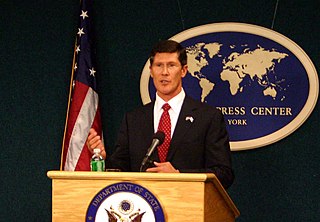
The Bear Stearns Companies, Inc. was an American investment bank, securities trading, and brokerage firm that failed in 2008 as part of the global financial crisis and recession. After its closure it was subsequently sold to JPMorgan Chase. The company's main business areas before its failure were capital markets, investment banking, wealth management, and global clearing services, and it was heavily involved in the subprime mortgage crisis.
A collateralized debt obligation (CDO) is a type of structured asset-backed security (ABS). Originally developed as instruments for the corporate debt markets, after 2002 CDOs became vehicles for refinancing mortgage-backed securities (MBS). Like other private label securities backed by assets, a CDO can be thought of as a promise to pay investors in a prescribed sequence, based on the cash flow the CDO collects from the pool of bonds or other assets it owns. Distinctively, CDO credit risk is typically assessed based on a probability of default (PD) derived from ratings on those bonds or assets.

E-Trade Financial Corporation, a subsidiary of Morgan Stanley, offers an electronic trading platform to trade financial assets. The company receives revenue from interest income on margin balances, commissions for order execution, payment for order flow, and management services.

John Alexander Thain is an American financial executive and investment banker. He was president and co-COO of Goldman Sachs, and then CEO of the New York Stock Exchange. Thain then became the last chairman and CEO of Merrill Lynch & Co. before its merger with Bank of America. He was designated to become president of global banking, securities, and wealth management at the newly combined company, but resigned on January 22, 2009. Ken Lewis, CEO of Bank of America, reportedly forced Thain to step down after several controversies, such as the losses at Merrill Lynch which proved to be far larger than previously estimated, and the award of huge executive bonuses. Thain then was chairman and CEO of the CIT Group. He has been a board member of Uber since 2017.

The 2000s United States housing bubble or house price boom or 2000shousing cycle was a sharp run up and subsequent collapse of house asset prices affecting over half of the U.S. states. In many regions a real estate bubble, it was the impetus for the subprime mortgage crisis. Housing prices peaked in early 2006, started to decline in 2006 and 2007, and reached new lows in 2011. On December 30, 2008, the Case–Shiller home price index reported the largest price drop in its history. The credit crisis resulting from the bursting of the housing bubble is an important cause of the Great Recession in the United States.

Merrill Lynch & Co., formally Merrill Lynch, Pierce, Fenner & Smith Incorporated, was a publicly-traded American investment bank that existed independently from 1914 until January 2009 before being acquired by Bank of America and rolled into BofA Securities.

The American subprime mortgage crisis was a multinational financial crisis that occurred between 2007 and 2010 that contributed to the 2007–2008 global financial crisis. The crisis led to a severe economic recession, with millions of people losing their jobs and many businesses going bankrupt. The U.S. government intervened with a series of measures to stabilize the financial system, including the Troubled Asset Relief Program (TARP) and the American Recovery and Reinvestment Act (ARRA).

An asset-backed securities index is a curated list of asset-backed security exposures that is used for performance bench-marking or trading.
The subprime mortgage crisis impact timeline lists dates relevant to the creation of a United States housing bubble and the 2005 housing bubble burst and the subprime mortgage crisis which developed during 2007 and 2008. It includes United States enactment of government laws and regulations, as well as public and private actions which affected the housing industry and related banking and investment activity. It also notes details of important incidents in the United States, such as bankruptcies and takeovers, and information and statistics about relevant trends. For more information on reverberations of this crisis throughout the global financial system see 2007–2008 financial crisis.
Nelson Joosuk Chai is an American investment banker and financial executive. He formerly served as the chief financial officer of American financial services company Merrill Lynch and briefly as Bank of America's president for the Asia-Pacific region. He is the former president of CIT Group and reported directly to then CEO John Thain. On August 21, 2018, it was announced that Chai has been hired as the chief financial officer of Uber.
A synthetic CDO is a variation of a CDO that generally uses credit default swaps and other derivatives to obtain its investment goals. As such, it is a complex derivative financial security sometimes described as a bet on the performance of other mortgage products, rather than a real mortgage security. The value and payment stream of a synthetic CDO is derived not from cash assets, like mortgages or credit card payments – as in the case of a regular or "cash" CDO—but from premiums paying for credit default swap "insurance" on the possibility of default of some defined set of "reference" securities—based on cash assets. The insurance-buying "counterparties" may own the "reference" securities and be managing the risk of their default, or may be speculators who've calculated that the securities will default.

Chain of Blame: How Wall Street Caused the Mortgage and Credit Crisis is a 2008 book about the subprime mortgage crisis in the United States by investigative journalists Paul Muolo of National Mortgage News and Mathew Padilla of the Orange County Register. The book has an accompanying website with some excerpts, author biographies and a roundup of events in the subprime mortgage crisis that occurred after the book was printed.
This article provides background information regarding the subprime mortgage crisis. It discusses subprime lending, foreclosures, risk types, and mechanisms through which various entities involved were affected by the crisis.
Credit rating agencies (CRAs)—firms which rate debt instruments/securities according to the debtor's ability to pay lenders back—played a significant role at various stages in the American subprime mortgage crisis of 2007–2008 that led to the great recession of 2008–2009. The new, complex securities of "structured finance" used to finance subprime mortgages could not have been sold without ratings by the "Big Three" rating agencies—Moody's Investors Service, Standard & Poor's, and Fitch Ratings. A large section of the debt securities market—many money markets and pension funds—were restricted in their bylaws to holding only the safest securities—i.e. securities the rating agencies designated "triple-A". The pools of debt the agencies gave their highest ratings to included over three trillion dollars of loans to homebuyers with bad credit and undocumented incomes through 2007. Hundreds of billions of dollars' worth of these triple-A securities were downgraded to "junk" status by 2010, and the writedowns and losses came to over half a trillion dollars. This led "to the collapse or disappearance" in 2008–09 of three major investment banks, and the federal government's buying of $700 billion of bad debt from distressed financial institutions.

The Last Days of Lehman Brothers is a British television film, first broadcast on BBC Two and BBC HD on Wednesday 9 September 2009. Filmed in London, it was written by Craig Warner and directed by Michael Samuels. It was shown as part of the BBC's "Aftershock" season, a selection of programmes marking the first anniversary of the collapse of the American investment bank Lehman Brothers. It featured James Cromwell, Ben Daniels, Corey Johnson, Michael Landes and James Bolam.
First Franklin Financial Corp., not to be confused with 1st Franklin Financial Corporation, was a San Jose, California-based home mortgage lender that specialized in subprime loans. It had been owned by two of the biggest casualties of the subprime mortgage crisis, National City Corp. in Cleveland and Merrill Lynch.
Magnetar Capital is a hedge fund based in Evanston, Illinois. The firm was founded in 2005 and invests in fixed-income, energy, quantitative, and event-driven strategies. The firm was actively involved in the collateralized debt obligation (CDO) market during the 2006–2007 period. In some articles critical of Magnetar Capital, the firm's arbitrage strategy for CDOs is described as the "Magnetar trade".

Inside Job is a 2010 American documentary film, directed by Charles Ferguson, about the late-2000s financial crisis. Ferguson, who began researching in 2008, said the film is about "the systemic corruption of the United States by the financial services industry and the consequences of that systemic corruption", amongst them conflicts of interest of academic research, which led to improved disclosure standards by the American Economic Association. In five parts, the film explores how changes in the policy environment and banking practices helped create the financial crisis.
Merrill, previously branded Merrill Lynch, is an American investment management and wealth management division of Bank of America. Along with BofA Securities, the investment banking arm, both firms engage in prime brokerage and broker-dealer activities. The firm is headquartered in New York City, and once occupied the entire 34 stories of 250 Vesey Street, part of the Brookfield Place complex in Manhattan. Merrill employs over 14,000 financial advisors and manages $2.8 trillion in client assets. The company also operates Merrill Edge, a division for investment and related services, including call center counsultancy.
Jeffrey Peek is a finance industry executive. He headed CIT Group from 2003 until it was reorganized following the 2008 financial crisis.










